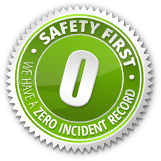More Tips On Safe Demolition Methods
In our last blog post, we highlighted some of our most important tips to residential builders for safety on the site. Here we continue that list.
Limit Exposure to Hazardous Materials
Lead paint. One hazard that’s frequently overlooked is the danger of torching steel beams that have been painted with lead paint. Simply cutting a few painted beams can expose a builder to airborne lead levels that are significantly higher than mandated limits. In these instances, OSHA requires workers to be provided with respirators, protective clothing and hand washing stations.
This is only one of a few materials that demolition companies must scrupulously monitor and prepare for when taking down buildings. In fact, OSHA has an entire set of standards for demolition procedures. If your team isn’t confident in this area, consider consulting with SV Demolition. As a longstanding, reputable demolition company, we have wide-ranging experience in taking down a broad array of structures. Our team can provide unique insight into how to best remove chemical hazards.
Fall protection
Because demolition companies are in the business of tearing things up and creating holes, we are acutely aware of the importance of fall protection. When working around any hole, open wall or open roof with a fall greater than 6 feet, demolition workers are typically required to wear full body restraints. These same hazards are often present during the construction phase, as well, which means fall protection is just as important for builders.
Recycling Concrete, Steel and other Materials
Green industrial demolition contractors know what may be recycled from a decayed building. This information can come in handy when residential builders are selecting earth-friendly building materials. From a commercial demolition perspective, the materials listed below can effectively be recycled upon demolition. In fact, with disposal costs as high as they are, it’s often worthwhile to pay for the labor it takes to separate them out.
- Concrete. A single demolition project can yield tons of concrete. Fortunately, this concrete may be crushed into gravel, a high-demand material in new building projects. Some industrial demolition contractors such as SVDI, employ mobile concrete crushers that can easily process all concrete on-site.
- Steel. With the right equipment and expertise, steel and other scrap metals can be processed for recycling into new products.
- Interior doors and beams. Wood doors, posts and beams in good condition can often be sold or reused – there are plenty of architectural salvage companies that are interested in these types of materials. If the condition is too poor for reuse, the wood can be recycled.
- Sinks and toilets. Again, if they’re in good condition, these fixtures can usually be reclaimed by an architectural salvage company. Otherwise, porcelain models can be recycled with the concrete, while stainless steel fixtures can be recycled with the other scrap metals.
Construction and demolition are the two ends of a building’s life cycle, so it makes sense that those responsible for each phase would have plenty to teach each other. If your contracting crew could use an injection of fresh building knowledge, consider contacting SV Demolition today for a consultation.

